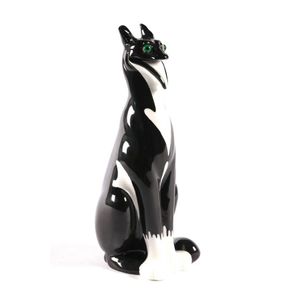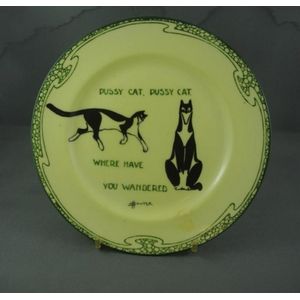
Royal Doulton 'The Tiff' Plate by David Henry Souter
Royal Doulton 'The Tiff' antique English porcelain cabinet plate designed by David Henry Souter, green factory mark to base, 24 cm diameter

Rare Royal Doulton Souter Kateroo Cat Figurine
Rare Royal Doulton Souter Kateroo cat figurine HN514, designed by David Henry Souter, 1862-1935 and modelled by Charles Noke, 1858-1941 black and white glaze, glass eyes missing, height 32 cm

Royal Doulton Souter Cat Vase - "Better Alone" - 10.5cm
Miniature Royal Doulton Souter cat vase 'Better Alone than in Bad Company', 10.5 cm high.

Royal Doulton Souter Cat Pin Dish
Royal Doulton Souter cat pin dish 'God Bless the Cat That Breaks the Crocks' 11 cm diameter.

"Kateroo" Jug by Royal Doulton - East West Best
Royal Doulton Souter 'Kateroo' jug titled 'East, West, Name's Best,' and signed Souter, marked to base and D4153, height 7 cm

Art Nouveau Lovers Plate by David Souter
David Henry Souter for Royal Doulton Kateroo plate 'The Lovers' with Art Nouveau painted yellow rim, printed factory mark to base, 23.75 cm diameter. Faint start crack.

Royal Doulton Kateroo Cup & Saucer with Sea Quote
Royal Doulton 'Souter's Kateroo' cup & saucer, 'Be content, the sea hath fish enough', both marked to base

Royal Doulton Kateroo Bowl (1906-1939)
Royal Doulton 'Souter's Kateroo' bowl circa 1906-1939, printed Souter mark, diameter 15.5 cm.

God Bless the Cat Dish
Royal Doulton 'Souter's Kateroo' bone china dish reading God bless the cat that breaks the crock in pieces very small, for thinks like that are good for trade and benefit US all.circa 1906-1939, printed Souter mark, width 9.5 cm, depth 12 cm.

Royal Doulton Souter's Kateroo Cup & Saucer
Royal Doulton 'Souter's Kateroo' cup & saucer 'Be Content The Sea Have Fish Enough', circa 1906-1939, printed Souter mark

Royal Doulton Souter's Kateroo Candlesticks
Two Royal Doulton 'Souter's Kateroo' candlesticks 'East West Hame's Best', circa 1906-1939, printed Souter mark, height 22 cm.

Green Glazed Royal Doulton Souter Kateroo Cat Figurine
Rare Royal Doulton Souter Kateroo cat figurine designed by David Henry Souter 1862-1935 and modelled by Charles Noke 1858-1941 with green glaze and green glass eyes, height 32 cm

Signed Royal Doulton Souter Kateroo Cup & Saucer
Rare Royal Doulton Souter Kateroo cup & saucer yellow in colour with 'here we go round the Mulberry bush', signed Souter to both pieces

Souter's Kateroo Cat Plate with Art Nouveau Border
Royal Doulton 'Souter's Kateroo' series ware plate 'The Honey Moon',decorated with two cats to the centre framed by a border incorporating four Art Nouveau female portraits alternating with four Souter cat caricatures on a pale cream ground. Printed…

Souter's Kateroo Plate with Cats and Art Nouveau Border
Royal Doulton 'Souter's Kateroo' series ware plate 'O Perfect Love',decorated with eight cats to the centre framed by a border incorporating four Art Nouveau female portraits alternating with four Souter cat caricatures on a pale yellow ground. Printed…

Royal Doulton 'Souter's Kateroo' Plate
Royal Doulton 'Souter's Kateroo' series ware plate 'The Gay Bachelor',decorated with a cats to the centre framed by a border incorporating four Art Nouveau female portraits alternating with four Souter cat caricatures on a pale yellow ground. Printed…

Royal Doulton Cat Plate with Art Nouveau Border
Royal Doulton 'Souter's Kateroo' series ware plate 'The Lovers',decorated with two cats to the centre framed by a border incorporating four Art Nouveau female portraits alternating with four Souter cat caricatures on a pale green & yellow ground. Printed…

Art Nouveau Cat Plate
Royal Doulton 'Souter's Kateroo' series ware plate 'The Wedding Tour', decorated with two cats to the centre framed by a border incorporating four Art Nouveau female portraits alternating with four Souter cat caricatures on a pale yellow ground. Printed…

Art Nouveau Cat Plate with Souter Caricatures
Royal Doulton 'Souter's Kateroo' series ware plate 'The Tiff',decorated with eight cats to the centre framed by a border incorporating four Art Nouveau female portraits alternating with four Souter cat caricatures on a pale yellow & cream ground. Printed…

Royal Doulton Twin Handle Cup and Bowl Set
Royal Doulton 'Souter Kateroo' twin handle cup twin handled bowl, with script: 'Pussy Cat, Pussy Cat, where have you wandered,' marked to base, height 12 cm

Royal Doulton Souter Cats Teacup & Saucer Set
Royal Doulton Souter cats teacup & saucer 14.6 cm diameter saucer, 6.8 cm high cup

Royal Doulton Kateroo Character Jug
Royal Doulton character jug Kateroo figure HN154, model 214. Black & white with green eyes. Modelled by Charles Noke. Designed by David Henry Souter. Height 32 cm

Royal Doulton Tobacco Jar & Dish Set "Kateroo"
Royal Doulton tobacco jar & dish be content the sea Hath fish Enough. Lidded tobacco jar, Kateroo. By Henry Souter (restored). Height 17 cm. Plus small dish Kateroo. By Henry Souter (restored)

Souter Cats Jug with Kataroo on Jack Daw Wall
Royal Doulton Souter cats jug, Kataroo sitting on Jack Daw Wall, Scene B, D28451905

Royal Doulton 'Souter' Plate - Kateroo the Tiff
Rare Royal Doulton 'Souter' plate, Kateroo - the Tiff, 24 cm diameter approx.

Royal Doulton Plates: Souter's Cats & All Black Cricketers
Two small Royal Doulton plates, one 'Souter's Cats', the other 'All Black' cricketers 'Their Style', slight wear to both.

Rare Royal Doulton 'Kateroo' Cat Figure by Souter and Noke
A rare Royal Doulton 'Kateroo' cat figure, designed by David Henry Souter (1862-1935) and modelled by Charles Noke (1858-1941), with yellow glaze and green glass eyes. Height 32.5 cm. (left ear as found)

Royal Doulton Souter Coffee Set with Motivational Message
Rare Royal Doulton Souter coffee can and two saucers, cup 'Better Alone than in bad company'

Royal Doulton Mulberry Bush Candlestick, 23cm
Rare Royal Doulton Souter 'Here we go round the Mulberry Bush' candlestick, approx 23 cm high

Rare Royal Doulton 'Souter' Saucer and Side Plate
Rare Royal Doulton 'Souter' saucer and side plate, D17.5 cm approx

Rare Royal Doulton 'Souter' Side Plate, Civil Service Stores Sydney
Rare Royal Doulton 'Souter' side plate white, scene 3, Civil service stores Sydney, 1901-06

Miniature Royal Doulton Souter Cat Plate
Miniature Royal Doulton Souter cat plate, approx 11 cm diameter

Royal Doulton Cat Plate - The Gay Bachelor
A Royal Doulton Souter's cat plate, 'The Gay Bachelor', the cat to the centre with a border of cats and nouveau women. Diameter 23.5 cm

Royal Doulton Souter Cats Milk Jug & Sugar Bowl
Royal Doulton Souter Cats milk jug & sugar bowl, David Henry Souter's 'Kateroo' character was featured on a series of Doulton china made at Burslem from 1906 to 1939. Star crack to base of milk jug.

Royal Doulton Souter Cats Trio
Royal Doulton Souter Cats series trio. David Henry Souter's 'Kateroo' character was featured on a series of Doulton china made at Burslem from 1906 to 1939.

Royal Doulton 'Souter's Cats' Teapot with Silver Spout
A Royal Doulton 'Souter's Cats' teapot, decorated with four cat caricatures and the rhyme 'Here We Go Round The Mulberry Bush', a sterling silver spout mounted to cover a chip. Printed mark, c.1906 - 1939. Diameter 15 cm

Souter's Cats Plate - The Lovers
A Royal Doulton 'Souter's Cats' series ware plate, 'The Lovers', decorated with two cats to the centre framed by a border incorporating four Art Nouveau female portraits alternating with four Souter cat caricatures on a pale green ground. Printed mark,…

Royal Doulton Souter's Cats Miniature Vase
A Royal Doulton 'Souter's Cats' series ware miniature vase, cylindrical shape with small loop handles at the shoulder, decorated with three cat caricatures and the abbreviated motto ' Be Content, The Sea (Hath) Fish Enough'. Printed mark. Height 10.3 cm

Art Nouveau Honeymoon Plate by David H. Souter
David Henry Souter for Royal Doulton, the Honeymoon plate Art Nouveau painted green rim, printed factory mark to base 'Civil service Store, Sydney'. Diameter 23.5 cm




 Loading more...
Loading more...